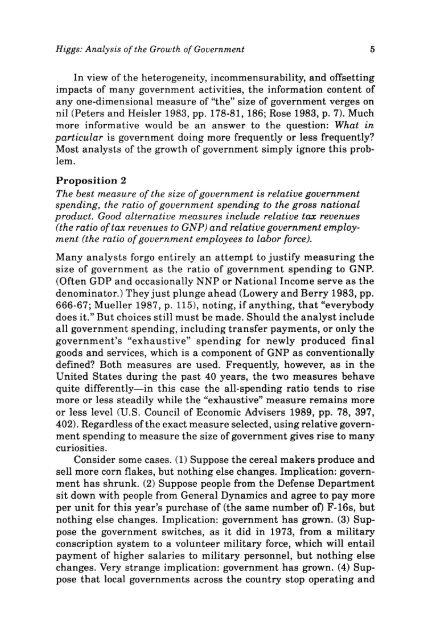Review of Austrian Economics - The Ludwig von Mises Institute
Review of Austrian Economics - The Ludwig von Mises Institute
Review of Austrian Economics - The Ludwig von Mises Institute
Create successful ePaper yourself
Turn your PDF publications into a flip-book with our unique Google optimized e-Paper software.
Higgs: Analysis <strong>of</strong> the Growth <strong>of</strong> Government 5<br />
In view <strong>of</strong> the heterogeneity, incommensurability, and <strong>of</strong>fsetting<br />
impacts <strong>of</strong> many government activities, the information content <strong>of</strong><br />
any one-dimensional measure <strong>of</strong> "the" size <strong>of</strong> government verges on<br />
nil (Peters and Heisler 1983, pp. 178-81, 186; Rose 1983, p. 7). Much<br />
more informative would be an answer to the question: What in<br />
particular is government doing more frequently or less frequently?<br />
Most analysts <strong>of</strong> the growth <strong>of</strong> government simply ignore this problem.<br />
Proposition 2<br />
<strong>The</strong> best measure <strong>of</strong> the size <strong>of</strong> government is relative government<br />
spending, the ratio <strong>of</strong> government spending to the gross national<br />
product. Good alternative measures include relative tax revenues<br />
(the ratio <strong>of</strong> tax revenues to GNP) and relative government employment<br />
(the ratio <strong>of</strong> government employees to labor force).<br />
Many analysts forgo entirely an attempt to justify measuring the<br />
size <strong>of</strong> government as the ratio <strong>of</strong> government spending to GNP.<br />
(Often GDP and occasionally NNP or National Income serve as the<br />
denominator.) <strong>The</strong>y just plunge ahead (Lowery and Berry 1983, pp.<br />
666-67; Mueller 1987, p. 115), noting, if anything, that "everybody<br />
does it." But choices still must be made. Should the analyst include<br />
all government spending, including transfer payments, or only the<br />
government's "exhaustive" spending for newly produced final<br />
goods and services, which is a component <strong>of</strong> GNP as conventionally<br />
defined? Both measures are used. Frequently, however, as in the<br />
United States during the past 40 years, the two measures behave<br />
quite differently—in this case the all-spending ratio tends to rise<br />
more or less steadily while the "exhaustive" measure remains more<br />
or less level (U.S. Council <strong>of</strong> Economic Advisers 1989, pp. 78, 397,<br />
402). Regardless <strong>of</strong> the exact measure selected, using relative government<br />
spending to measure the size <strong>of</strong> government gives rise to many<br />
curiosities.<br />
Consider some cases. (1) Suppose the cereal makers produce and<br />
sell more corn flakes, but nothing else changes. Implication: government<br />
has shrunk. (2) Suppose people from the Defense Department<br />
sit down with people from General Dynamics and agree to pay more<br />
per unit for this year's purchase <strong>of</strong> (the same number <strong>of</strong>) F-16s, but<br />
nothing else changes. Implication: government has grown. (3) Suppose<br />
the government switches, as it did in 1973, from a military<br />
conscription system to a volunteer military force, which will entail<br />
payment <strong>of</strong> higher salaries to military personnel, but nothing else<br />
changes. Very strange implication: government has grown. (4) Suppose<br />
that local governments across the country stop operating and

















